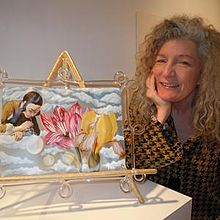Ginny Ruffner
Ginny Ruffner | |
|---|---|
 | |
| Born | 1952 Atlanta, Georgia |
| Nationality | American |
| Alma mater | University of Georgia |
| Known for | Glass artist |
| Website | ginnyruffner |
Ginny Ruffner (born 1952) is an American glass artist based in Seattle, Washington. She is known for her use of the flameworking technique. She also started painting on glass after seeing The Bride Stripped Bare by Her Bachelors, Even (The Large Glass), a glass painting by Marcel Duchamp.[1]
Early life[]
Ruffner was born in 1952 in Atlanta, Georgia. Her father was an FBI agent, and her mother was a typing teacher.[2]
Education[]
Ruffner studied at Furman University in Greenville, South Carolina, and Winthrop College in Rock Hill, South Carolina, before transferring to the University of Georgia, where she received a BFA in Drawing and Painting in 1974 and an MFA in Drawing and Painting in 1975.[2][3] Following graduation, one of Ruffner's first jobs was creating glass animals while working as an apprentice lamp worker. In the early 1980s, she relocated to Seattle and taught at Pilchuck Glass School.[4]
Career[]

Ruffner's first solo exhibition was at Georgia Tech Gallery in Atlanta in 1984, followed by solo and group exhibitions at museums such as the Corning Museum of Glass; High Art Museum; Los Angeles County Museum of Art; Montreal Museum of Fine Arts; Museum of Arts and Design; Museum of Fine Arts, Boston; Museum of Glass; Museum of Northwest Art; and Toledo Museum of Art, among others.[citation needed]
Her work is in the permanent collections of the Metropolitan Museum of Art, Cooper-Hewitt Museum, the Corning Museum of Glass, the Detroit Institute of Art and the Smithsonian Museum of American Art.[4][1]
She was profiled on the NPR show Weekend America on March 18, 2006.
She was the subject of a documentary, Ginny Ruffer: A Not So Still Life (2010), which won the Golden Space Needle Award - Best Documentary at the Seattle International Film Festival that year.[5]
Personal life[]
Entering her thirtees, Ginny Ruffner scored high enough on an IQ test to be accepted to Mensa and Intertel, two high-IQ societies.[6]
In 1991, Ruffner was involved in a three-car collision that almost took her life. She was in a coma for five weeks. Doctors thought she would never walk or talk again. She was in the hospital for five months and in a wheelchair for five years. The accident left her with speech and mobility issues.[7][8]
References[]
This article uses public domain text from the Voice of America article cited below.
- ^ Jump up to: a b "Ginny Ruffner | Smithsonian American Art Museum". americanart.si.edu. Retrieved 2017-01-30.
- ^ Jump up to: a b "Oral history interview with Ginny Ruffner, 2006 September 13-14". www.aaa.si.edu. Retrieved 2017-01-28.
- ^ "Ginny Ruffner, Artist - Education". www.ginnyruffner.com. Retrieved 2017-01-28.
- ^ Jump up to: a b "U.S. Department of State - Art in Embassies". art.state.gov. Retrieved 2018-06-14.
- ^ "Golden Space Needle Award Winners". Seattle International Film Festival. Retrieved 2017-01-30.
- ^ "Ruffner, Ginny (b. 1952)". www.historylink.org. Retrieved 2021-09-04.
- ^ "Artist Reinvents Herself After Near-Fatal Accident". Voice of America. March 20, 2012. Retrieved 2019-11-09.
- ^ Easton, Valerie (December 3, 2011). "Seattle artist Ginny Ruffner's garden is a party". Pacific NW. Archived from the original on 2014-03-19.
Further reading[]
- Miller, Bonnie J. (1995). Why Not?: The Art of Ginny Ruffner. Seattle: Tacoma Art Museum in association with the University of Washington Press. ISBN 978-0-295-97508-5.
External links[]
| Wikimedia Commons has media related to Ginny Ruffner. |
- Personal website
- "Ginny Ruffner Unlimited," a 2003 essay about Ruffner by Vicki Halper in connection with the Montgomery Museum of Fine Arts exhibit Creativity: The Flowering Tornado, Art of Ginny Ruffner.
- Profile on NPR's Weekend America
- Profile on AskArt
- Q&A on The Corning Museum of Glass blog
- 1952 births
- Living people
- 20th-century American women artists
- 20th-century American artists
- Artists from Atlanta
- Furman University alumni
- Glass artists
- Women glass artists
- University of Georgia alumni
- Fellows of the American Craft Council
- Mensans